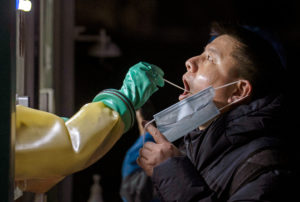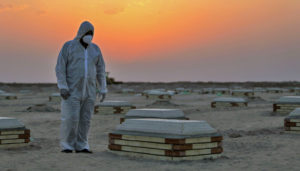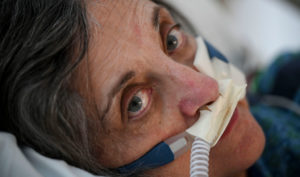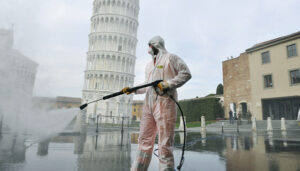Dwight Eisenhower’s final public address as president is best-remembered for his warning about the rise of the military-industrial complex. But contained within his speech was another stark prophecy, one which has largely been forgotten yet remains just as significant. The “domination of the nation’s scholars by Federal employment, allocations, and the power of money” is a grave threat, he cautioned. “Public policy could itself become the captive of a scientific-technological elite.”
And so the biological-industry complex was also born, swept into being as the US started to reckon with the inevitability of biological warfare and bioterrorism — an inevitability that arrived just one week after 9/11, when envelopes of inhalation anthrax were mailed around the country. But, as with the military-industrial complex, the emergence of America’s biodefense infrastructure was about much more than defending against potential threats. It was about anticipating them, understanding them, spying on them, and creating them. In many ways, the sense of urgency echoed the Manhattan Project, which showed just how quickly a “scientific-technological elite” could coalesce around a military project of strategic value. Consequently, American biodefence today spans the Departments of Defense, Homeland Security, Agriculture, the FBI, the State Department, and the Intelligence Community (not to mention state-level agencies).
Curiously, however, it also appears to have spread into American foreign aid. In April, Samantha Power, the former human rights activist and Obama hand now serving as administrator of United States Agency for International Development (USAID), testified before the Senate Foreign Relations Committee. Senator Rand Paul asked: “Did USAID fund coronavirus research in Wuhan?” In response, Power was evasive, referring repeatedly to USAID funding of the Wuhan lab having taken place “before my time”. But Power’s testimony raises a much bigger question: Why was USAID funding risky research in a Chinese lab that the US Department of Energy and the FBI now assess to be the source of Covid at all?
Since the heady days of the pandemic, when top scientists resorted to burner phones and clandestine meetings, journalists have uncovered thousands of pages of redacted emails, deleted virus sequences, and concealed events related to the outbreak of Covid. Among the key revelations of this years-long investigation was the enormous sums of US government funding spent on risky virus research around the world, but with a particular emphasis on China. The vast majority of this money was funnelled through a New York-based NGO called EcoHealth Alliance, led by British zoologist Peter Daszak. And by far the largest portion of US money channelled through EcoHealth — no less than $65 million — came from USAID. Not even the pandemic could put a stop to investment. As recently as late 2021, well after EcoHealth Alliance had been rebuked by the National Institutes of Health (NIH) for improper practices regarding its funding of the Wuhan lab, USAID gave EcoHealth Alliance a further $4.67 million.
This was merely the latest in a long series of funding rounds. EcoHealth received its first installment from USAID in 2009. The money would come from a then-novel USAID programme called Predict, whose mission was to hunt out viruses that jump from animals to humans and could potentially cause a pandemic. Predict was the brainchild of Dennis Carroll, an infectious diseases expert who had run USAID’s Pandemic Influenza and Other Emerging Threats (PIOET) Unit.
Carroll had permanently joined USAID in 2005 — a critical year for the agency, but also for the country. Two years prior, an outbreak of avian flu, or H5N1, had decimated poultry stocks and infected around 1,000 people around the world. The outbreak heightened a sense of terror of biological agents that had gripped the Bush Administration since the anthrax attack. In response, the Bush administration increased non-military biodefence funding from a paltry $60 million 2001 to a staggering $2 billion in 2003 — in addition to $6 billion dedicated solely to the development and stockpiling of vaccines. Just as importantly, with the 2004 presidential directive called Biodefense for the 21st Century, based on the assumption that “a bioweapons attack could devastate America”, Bush would lay the foundations for America’s first biodefence infrastructure.
At USAID, a similarly seismic change was underway. Under the leadership of Andrew Natsios, a longtime Republican political operative who started his career in politics running the 1990 primary campaign of George H.W. Bush, USAID would take a dramatic shift towards America’s defence establishment, becoming “a quasi-security agency”, as British professor of conflict studies Alice Hills wrote in a 2006 paper. This began in 2005 when USAID created its Office of Military Affairs (now the Office of Civilian Military Cooperation). “Uniforms [of US military personnel] in the corridors of the Ronald Reagan Building that houses USAID are now so commonplace they are not even noticed,” Henrietta Fore, the USAID administrator from 2007 to 2009, wrote in Parameters journal in 2008. “This is not the way things used to be.”
In 2009, USAID was forced to ramp up its efforts when another seismic event in the world of biological-threat preparedness took place: a novel influenza virus called H1N1, swine flu, which infected around one billion people and killed tens of thousands. In May 2009, Carroll testified before Congress that USAID had announced the launch of a new Emerging Pandemic Threats (EPT) Program, which would create “a global early warning system for the threat posed by diseases of animal origin that infect humans”. The programme, which in various forms ran until 2019 was slated to consist of four projects: Predict, Respond, Identify and Prevent — with the first, Predict, granted around $200 million in funding over two five-year funding cycles. (A follow-up USAID virus program called STOP Spillover was announced in May 2020 with a $100 million budget before getting quietly shelved.)
With Predict, USAID sought to “identify the emergence of new infectious diseases in high-risk wildlife, such as bats, rodents, and non-human primates, that could pose a major threat to human health”. Under Carroll’s leadership, however, Predict went much further than identifying the “emergence” of dangerous new viruses. Instead, it started actively hunting them out. It sampled more than 164,000 animals and people and sourced more than 1,100 unique viruses, including strains of Ebola, Marburg, MERS- and SARS-like coronaviruses, 949 of which were not previously known. In doing so, Predict introduced a completely new kind of pandemic risk: giving these deadly, unknown viruses a direct pathway to become introduced to large human populations living nearby.
Given the risk, the benefits would presumably need to be at least as great. But a highly influential 2017 paper by Emma L. Geoghegan and Edward Holmes demonstrated that the predictive value of the programme wasn’t merely of dubious value but of no value at all. “[E]fforts to predict disease emergence commonly conflate fundamentally different evolutionary and epidemiological time scales, and are likely to fail because of the enormous number of unsampled viruses that could conceivably emerge in humans,” the paper stated.
Nevertheless, the programme’s leaders were certain that Predict worked. A 2012 article published by the journal PLOS concluded that, as a result of Predict and EPT: “China has made a series of changes to public health policy and infrastructure specifically targeting SARS-like illnesses… It is likely that any future spillover from SARS… would be less likely to result in international spread.” One of the main authors of the paper was Dennis Carroll. Another was Peter Daszak.
It would be less than seven years from the publication of that paper before a pandemic would be caused precisely by a SARS-like pathogen originating in China. This raises the very serious question of how the world’s leading experts on pandemics, who commanded nine-figure budgets to monitor populations for exactly this kind of emerging virus, failed to even detect its emergence.
The reality is that Predict was doing more than detecting dangerous pathogens: it was helping labs make them. In May 2021, the office of US House Representative Guy Reschenthaler released a report showing that USAID had funnelled $1.1 million to the Wuhan Institute of Virology (WIV) through the EcoHealth Alliance. Among the work funded by USAID was a 2015 study jointly conducted by Shi Zhengli, the infamous “bat lady” of the Wuhan Institute of Virology, and the University of North Carolina researcher Ralph Baric, which used reverse genetics to insert a spike protein from a wild coronavirus capable of binding to a human receptor into the SARS-1 virus. The new lab-made virus was shown to bind to the human receptors and replicate “efficiently”, according to a House Foreign Affairs committee report.
The 2015 study — which the Bulletin of Atomic Scientists characterised as a “prototype” for making SARS-CoV-2 in a lab — was considered so dangerous that its authors did not upload the resulting sequence to GenBank, the NIH’s genetic research repository, for fear it might “fall into the wrong hands”, as Baric, its lead author, would later attest. But the study also omitted one other critical piece of information: USAID had provided funding for the study. Nature Medicine, the journal that published the paper, was forced to add a “Corrigendum” clarifying that the aid agency had in fact funded it.
Funding this kind of research in China added a whole other dimension of risk. According to the State Department, the Wuhan Institute began collaborating with the People’s Liberation Army no later than 2017. NBC News reported that in spring 2018, the Wuhan Institute’s Shi collaborated with military scientists specifically on coronavirus research. And in April 2020, it was revealed that the Wuhan Institute worked with Chinese military researchers to conduct research on Covid in humanised mice cells for the purposes of investigating the new disease. (US government investigators later found that the mice cells used specifically for Covid testing would have been created in the summer of 2019 — months before the pandemic began.)
There is little doubt that the US had, and still has, a global premium on the equipment, expertise, and ambition to do this type of research. So why would the NIH, let alone the USAID, fund such research in, of all places, a lab in China?
Among the four pillars of “Biodefense in the 21st Century”, Bush’s strategy that gave rise to programmes like Predict, was one called “Threat Awareness”. It indicated that the US was “improving the Intelligence Community’s ability to collect, analyze, and disseminate intelligence [on bioweapons]”. Of all places, China would almost certainly be at the top of any list of bioweapons intelligence targets. Though the nation is a signatory to the Biological Weapons Convention (BWC), the State Department found in 1993 that its bioweapons activities continued long after its accession in 1984. A 2002 report by The Nonproliferation Review found that one of a number of PRC-connected factories producing bioweapons was located in Wuhan. It was there that Shi Zhengli was conducting her own cutting-edge virus research, though under the banner of scientific research.
While failing to anticipate, or even identify, the Covid pandemic, Predict could have given American intelligence access to the findings of virus researchers such as Shi Zhengli, not just in China but around the world. In which case, given the sums associated with America’s defence and intelligence budgets, the project’s hefty $200 million lifetime budget would have paid for itself.
It wouldn’t have been the first time that international aid programmes have been used to gather intelligence. In 2014, it was reported that USAID had been caught trying to create a version of Twitter in Cuba that would help the CIA influence the political situation, with an eye to overthrowing the government. “USAID, perhaps, is the new CIA here,” Peter Kornbluh of the National Security Archive’s Cuba said at the time. The programme backfired, eventually allowing the Castro government to spy on the 40,000 Cubans who signed up.
Have USAID’s intelligence efforts failed again? In September 2019, the Wuhan Institute, with no explanation, took its database of viruses offline — a database populated by efforts funded, in part, by Predict. It was only months later, in March 2020, that Predict was brought to a close. But far from being the end of the programme, Predict’s demise was only the beginning of a much bigger and bolder incarnation of it.
The Global Virome Project (GVP), a $3-billion private venture to “identify and characterize, within a decade, 99% of all zoonotic viruses with epidemic/pandemic potential”, was envisioned as Predict on steroids. Not coincidentally, it was created and led by the same people at the centre of Predict, including Dennis Carroll, Peter Daszak and Predict’s principal investigator Jonna Mazet. Like Predict, the GVP would be rooted in tight cooperation not just with the Chinese government (one of the co-authors of the Science paper announcing its launch was George Gao, then head of the Chinese CDC), but specifically the lab in Wuhan. “The Wuhan Institute of Virology… is the forerunner to the Global Virome Project,” a 2018 State Department cable from the US consulate in Wuhan reported. “China has expressed interest in building the GVP database… Other countries…are skeptical on whether China could remain transparent as a ‘gatekeeper’ for this information.”
In addition to the Chinese government, a core partner in the GVP was health-tech company Metabiota. Led by a PR-savvy “virus hunter” named Nathan Wolfe, Metabiota played a key role in USAID’s Predict, despite having been accused of running a “bungled” response to the Ebola outbreak in 2014. The company received around $24 million in funding from the Department of Defense, funding that is alleged to have been facilitated by Hunter Biden, whose investment firm, Rosemont Seneca, led a $25 million investment round in Metabiota, investing $10 million for a 13% stake in the company. Emails revealed by US Right to Know show that, while building the GVP, Carroll (using his USAID email address) earmarked hundreds of thousands of dollars in USAID funding to Metabiota, possibly in violation of federal law.
Since then, even in the wake of a pandemic that it might have caused, the power of the biological-industrial complex has continued to grow. Funding to EcoHealth Alliance has been fully restored. Everyone from Anthony Fauci to Samantha Power to Anthony Blinken is able to calmly sit in front of a powerful senator and explain that documents regarding the research done at Wuhan, subsidised by USAID, NIH and the State Department, will not, after all, be forthcoming. When I asked USAID about Predict, a spokesperson said: it “focused on understanding viral risk” and lowered “the pandemic risk in several ways”. They also stated: “USAID has never funded gain of function or dual use research of concern activities.” But it still remains unclear what exactly it did fund. With 20 million people dead and the world no closer to answers regarding what actually caused the pandemic — not the scientific method, but the policies, people, and institutional corruption — we can only continue to pose questions that have, for three years, gone glaringly unasked.
Disclaimer
Some of the posts we share are controversial and we do not necessarily agree with them in the whole extend. Sometimes we agree with the content or part of it but we do not agree with the narration or language. Nevertheless we find them somehow interesting, valuable and/or informative or we share them, because we strongly believe in freedom of speech, free press and journalism. We strongly encourage you to have a critical approach to all the content, do your own research and analysis to build your own opinion.
We would be glad to have your feedback.
Source: UnHerd Read the original article here: https://unherd.com/





